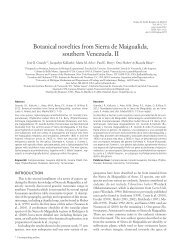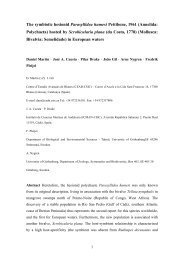PhD Thesis MJProl .pdf - digital-csic Digital CSIC - Consejo Superior ...
PhD Thesis MJProl .pdf - digital-csic Digital CSIC - Consejo Superior ...
PhD Thesis MJProl .pdf - digital-csic Digital CSIC - Consejo Superior ...
You also want an ePaper? Increase the reach of your titles
YUMPU automatically turns print PDFs into web optimized ePapers that Google loves.
ABSTRACT<br />
Abstract<br />
The purpose of this Ph.D. <strong>Thesis</strong> was to study the immobilization of the probiotic<br />
strain Phaeobacter 27-4 in biofilters as a new strategy for the control of Vibrionaceae<br />
infections in turbot (Psetta maxima) larval rearing. This new strategy guarantees the<br />
permanence of the probiotic bacteria in the rearing system and protects turbot larvae<br />
against the fish pathogen Listonella anguillarum 90-11-287 at the beginning of<br />
exogenous feeding on the rotifer Brachionus plicatilis.<br />
As a first step to accomplish the objectives, a reproducible and specific real-time<br />
PCR method was developed for detection and quantification of the fish probiotic<br />
Phaeobacter 27-4 and the target pathogens L. anguillarum 90-11-287 and V. splendidus<br />
DMC-1 in presence of all the organisms involved in turbot larval rearing: microalgae<br />
(Isochrysis galbana), rotifers (Brachionus plicatilis), Artemia nauplii and turbot larvae.<br />
The developed real-time PCR protocol allowed monitoring and quantification of<br />
probiotic and pathogenic bacteria during in vivo trials.<br />
As rotifer is the usual way of entry for potential pathogenic Vibrionaceae into fish<br />
larvae, in a second step in this Ph.D. <strong>Thesis</strong>, the colonization and residence time of two<br />
pathogenic Vibrionaceae strains (L. anguillarum 90-11-287 and V. splendidus DMC-1)<br />
in rotifers were studied. L. anguillarum colonized rotifers more efficiently than V.<br />
splendidus and both pathogenic strains were released from rotifers to seawater, after<br />
infected rotifers were transferred to rearing tanks. Residence time of L. anguillarum was<br />
longer than for V. splendidus, being released slower to surrounding seawater. V.<br />
splendidus grew and became predominant in the seawater of tanks. Both pathogens<br />
remained in rotifer or seawater enough time to infect fish larvae, but their different<br />
behaviour could determine different infection patterns, preferentially by ingestion of<br />
prey or by active intake or contact with surrounding seawater.<br />
The effect of L. anguillarum and V. splendidus on the bacterial community<br />
associated with rotifers and seawater of rearing tanks was analysed by DGGE of PCRamplified<br />
16S rDNA fragments. The bacterial community of rotifers did not present<br />
marked species dominance, being composed by Gram negative bacteria belonging to α-<br />
Proteobacteria, γ-Proteobacteria, Cytophaga-Flexibacter-Bacteroides group and a Gram<br />
positive bacterium (Microbacterium sp). The incorporation of L. anguillarum or V.<br />
splendidus did not reduce bacterial diversity and shifts in bacteria populations could be<br />
explained by bacterial exchange between rotifers and seawater.<br />
xvii

















